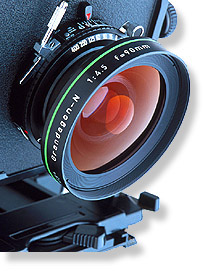|
Large format lens Large format lenses are photographic optics that provide an image circle large enough to cover the large format film or plates used in large format cameras. Photographic optics generally project a circular image behind that is only required to have acceptable correction of aberrations over the intended film/sensor diagonal with little room to spare. Lenses that may be able to produce a considerably larger image circle than is needed (notably long focus lenses), but optimised for a given image format will typically mask this excess coverage off to minimize reflections and reduced contrast. However, Some Medium and Large format cameras have movements, such as view cameras also sometimes known as technical cameras. Allowing the lens to be shifted and/or tilted from the sensor/film axis without vignetting in the corners opposite the movement requires a larger image circle. For this reason, large format lenses often produce image circles significantly larger than the film/sensor diagonal they are nominally aimed at Compared to mainstream cameras that typically have non-interchangeable lenses and/or focal plane shutters operated from the camera body, another difference with medium and especially large format lenses is that they are typically interchangeable in a very simple manner, being mounted in a "lens board", and include a shutter just in front behind or usually in the middle of the lens. This shutter is tripped directly at the lens (possibly using a cable release), not by a release on the camera body Lens designsNote: much of the text in this section is applicable to camera lenses for all formats, not only large format lenses Lenses of the same general construction are often given a name implying this design. For example, a Tessar always has four elements in three groups as described below, although Tessars have been produced with different focal lengths and maximum apertures for many decades. Sometimes a name does not identify a specific design; Kodak's Ektar lens brand name encompasses many different types. Sometimes different manufacturers use different names for lenses of the same type; for example, the Voigtländer Skopar is of Tessar design. And sometimes identical lenses are sold under different names and at different prices; for example, lenses branded as Rodenstock and Calder. Early lenses suffered from flare and low contrast, worsening as the number of lens-air interfaces increased. The introduction of and improvements in anti-reflective coatings vastly reduced flare; some many-element lens designs which had been abandoned due to low contrast in spite of otherwise excellent performance became practical. Lenses designed for use with monochromatic film, first orthochromatic, then panchromatic, had less exacting requirements regarding chromatic aberrations than when colour film is used. When using older lenses today one should check those chromatic aberrations and flare are acceptable for the application. Wide-angle lens designsThe term wide-angle lens denotes a lens that has an image circle diameter significantly wider than the lens focal length
Normal lens designsThe term wide-angle lens denotes a lens that has an image circle diameter approximately the same as the lens focal length
The Tessar design is suitable for front-element focussing, but unit focussing is used on large format cameras.
Telephoto lens designsThe term long-focus lens denotes a lens that has a focal length significantly longer than the image circle diameter. For small formats such as 35mm, extreme long focus lenses can be found, with focal lengths 5, 10, or even higher multiples of the image circle, however, such extreme lenses are not normal for large formats (unless we chose to consider astronomical telescopes as cameras, which is very valid, indeed see eg Schmitt cameras and astrographs) The term telephoto has become widely if loosely used for any long-focus lens, but a true telephoto lens is designed to be physically shorter* than a simple lens of that long focal length. Typically this is achieved with a diverging group (sometimes known as the telephoto group) between the converging front group and the film/sensor. As a bonus, this rear diverging group often acts to flatten the focal plane (that would result from spherical aberrations of the front group if not corrected)
See alsoReferencesExternal links
|
Portal di Ensiklopedia Dunia










